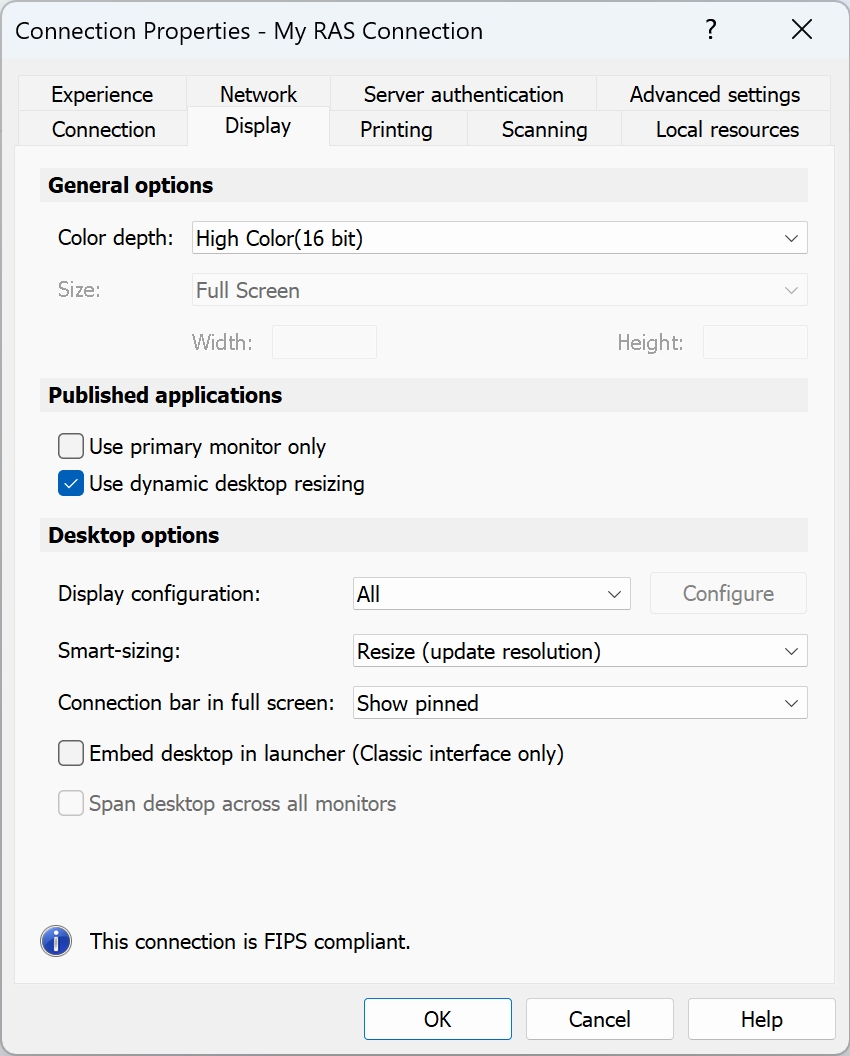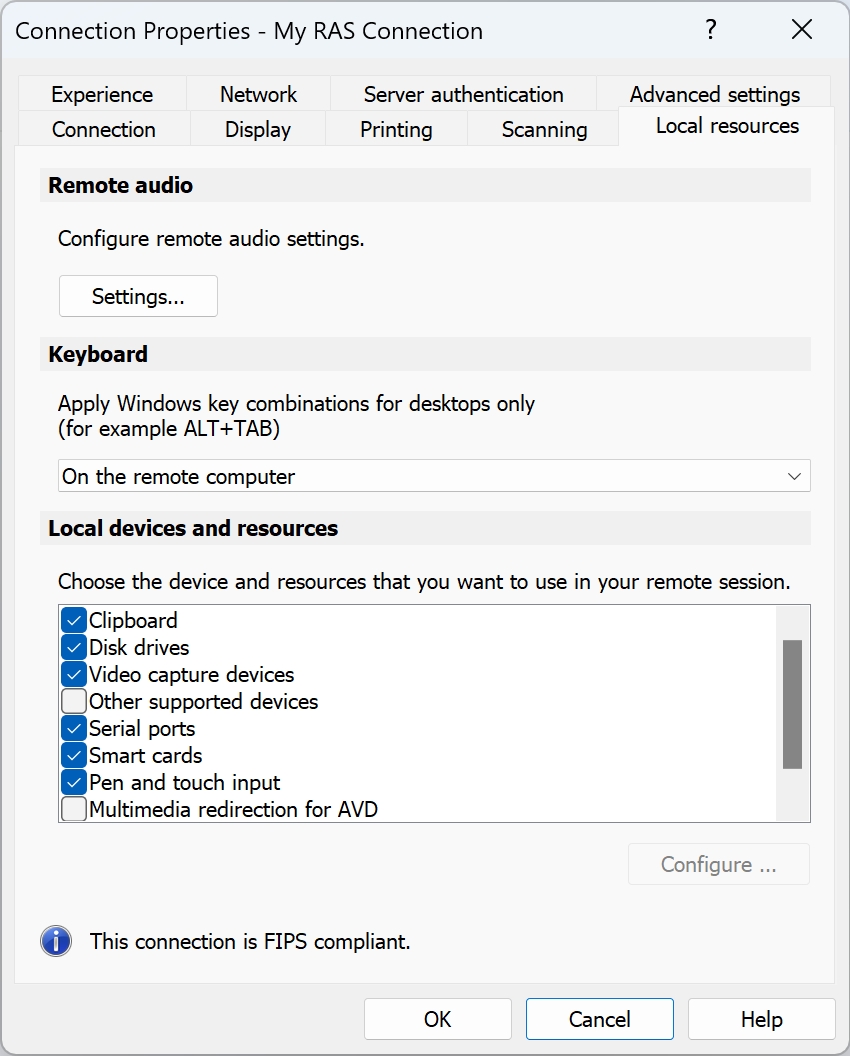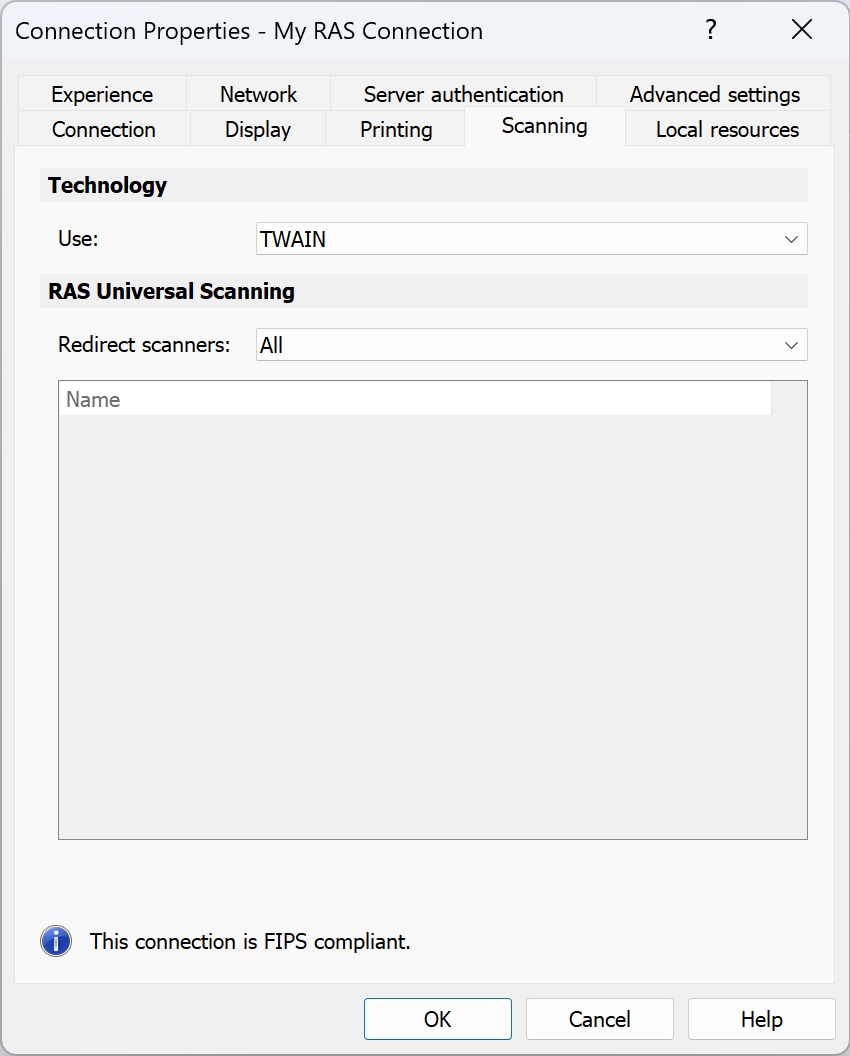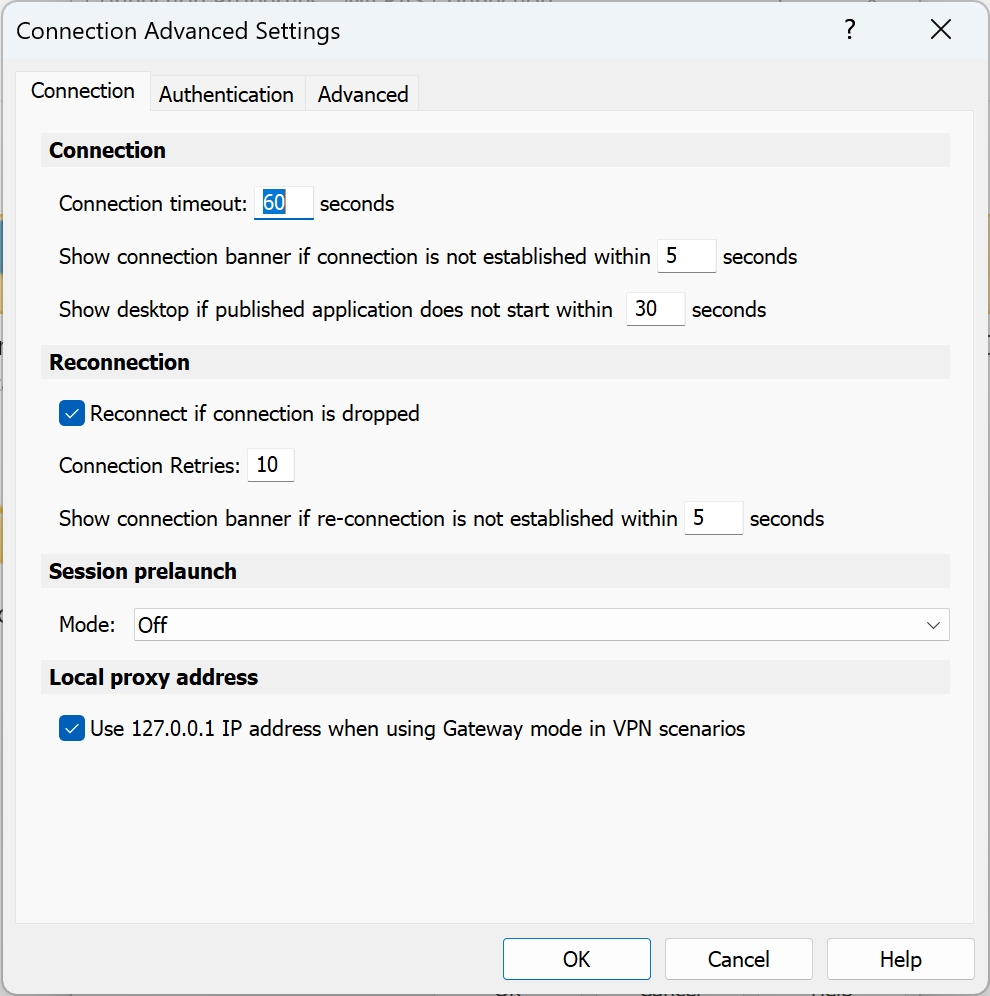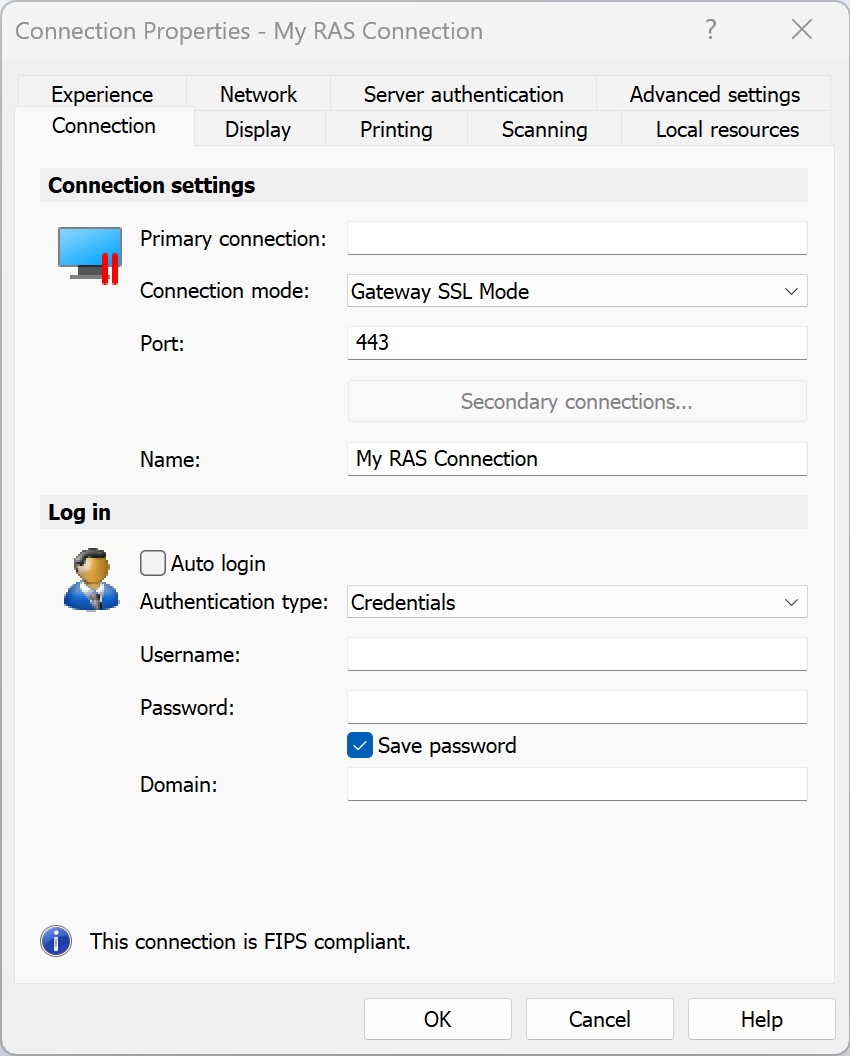
Loading...
Loading...
Loading...
Loading...
Loading...
Loading...
Loading...
Loading...
Loading...
Loading...
The Connection tab page allows you to specify connection properties and login information.
On the Connection tab page, configure the primary connection and one or more secondary connections.
The primary connection is what Parallels Client will use first to connect to the specified server. This should be the server where the primary RAS Secure Gateway is running.
To specify the primary connection information:
In the Primary connection field, specify the server name or IP address. To connect to a specific RAS Theme, specify its name after the server name or IP address separated by a slash. For example, workspaceus.parallelsras.net/theme1. If not sure which Theme you should use, ask your system administrator.
You can click the [...] button and select a server from the list. If the server is not listed, it means that the system administrator disabled this functionality on the server side. In such a case, specify the server by typing its name or IP address in the Primary Connection field.
Note for Administrators: The Broadcast RAS Secure Gateway Address option must be enabled on the server side for the [...] button to display the server.
In the Connection mode drop-down list, select one of the following options:
Gateway Mode: Parallels Client connects to the RAS Secure Gateway and the session connection is tunneled through the first available connection. This mode is ideal for servers which are only reachable via the gateway and do not require a high level of security.
Gateway SSL Mode: Same as the gateway mode above, but uses encryption to secure the data.
Direct Mode: Parallels Client first connects to the RAS Secure Gateway for the best available terminal server and then connects directly to that particular server. This is best used when the Parallels Client and the terminal server are on the same network.
Direct SSL Mode: Same as the direct mode above, but uses encryption to secure the data.
In the Port field, specify the port on which the gateway listens for incoming connections. If the default value has been modified on the server side, you have to replace the default value here as well. Otherwise, leave the default value intact.
In the Friendly Name field, choose and type a name of your choice.
If the server you are connecting to has more than one RAS Secure Gateway, you can define a secondary connection, which will be used as a backup connection in case the primary connection fails.
To add a secondary connection:
Click the Secondary Connections button.
In the Secondary Connections dialog, click the Add button and specify a server name or IP address. This should be a server hosting a secondary RAS Secure Gateway (the primary gateway is used by the primary connection). You can click the [...] button and select a server from the list. If none are available (or if the desired server is not in the list), type the server info in the field provided.
Select the connection mode and modify the port number if necessary. Click OK.
Back in the Secondary Connections dialog, you can move connections up or down the list if you have more than one. If the primary connection cannot be established, Parallels Client will use secondary connections in the order listed.
Click OK.
In the Logon section, specify the following properties:
Select the Auto start option to enable Parallels Client to connect automatically (using this connection) on startup.
In the Authentication type drop-down list, select the desired method of authentication:
Credentials: Select this option and then enter the username, password, and domain information. You will be authenticated on the remote server using the specified credentials.
Smart Card: Select this option to authenticate using a smart card. When connecting to the remote server, insert a smart card into the card reader and then enter a PIN when prompted.
Single Sign-On: This option will be included in the list only if the Single Sign-On module is installed during Parallels Client installation. Select this option to use local system credentials to connect to the remote server.
Web: Select this option to use the SAML SSO authentication.
Web + Credentials. The same as Web, but you will be prompted to enter credentials when you launch a published application.
Note for Administrators: The allowed authentication type(s) must be specified in the RAS Console in Connection / Authentication.
The Experience tab page allows you to tweak the connection speed to optimize the performance of the connection with the remote server.
In the drop-down list, select your connection speed:
If not sure, select the Detect connection quality automatically option. Please note that if you select this option, all other options, except Enable Compression, will be disabled and will be configured automatically based on the actual connection speed when Parallels Client is connected to Parallels RAS.
If you select a specific speed (e.g. LAN 10 Mbps or higher), select the desired user experience options. If you are connecting to a remote computer on a local network that runs at 100 Mbps or higher, it is usually safe to have all of the experience options turned on. Otherwise, select only the options that you require.
It is also recommended to enable compression to have a more efficient connection by selecting the Enable Compression option.
Enhance windows move/size: Enable this option if you experience graphics artifacts (dark squares) while moving or resizing a remote application window. The issue may manifest itself when an application is hosted on Windows Server 2012 or 2016 and when the Show contents of window while dragging option is enabled.
Use the Local resources tab page to configure how local resources are used in a remote session.
Click the Settings button to configure remote audio playback and recording options.
In the Remote audio playback section, Use the Where drop-down list to select one of the following remote audio playback options:
Bring to this computer. Audio from the remote computer will play on your local computer.
Do not play. Audio from the remote computer will not play on your local computer and will be muted on the remote computer as well.
Leave at remote computer. Audio will not play on your local computer but will play normally on the remote computer.
Use the Quality drop-down list to adjust the audio quality:
Dynamically adjust based on available bandwidth. This option will increase or decrease the audio quality based on your connection speed. The faster the connection, the higher audio quality setting will be used.
Always use medium audio quality. The audio quality is fixed at the medium level. You can use this option when you don't require the best possible audio quality and would rather use the available bandwidth for graphics.
Always use uncompressed audio quality. The audio quality is fixed at the highest level. Select this option if you have a very fast connection and require the best possible audio quality.
The Enable recording (if applicable) option allows you to enable audio recording on the remote computer. For example, you can speak into a microphone on the local computer and use a sound recording application on the remote computer to record yourself.
Select how you want to apply key combinations (e.g. Alt+Tab) that you press on the keyboard:
On the local computer. Key combinations will be applied to Windows running on the local computer.
On the remote computer. Key combinations will be applied to Windows running on the remote computer.
In full screen mode only. Key combinations will be applied to the remote computer only when in the full-screen mode.
Choose local disk drives, devices, and other resources that you want to redirect to a remote computer. Redirecting a resource makes it available for use in a remote session. For example, a redirected local disk drive will be available in a remote application, so you can read from and write to it.
The following options are available:
Clipboard. Select this option to enable the clipboard in a remote session. Click the Configure button and choose clipboard redirection from one of the following: Bidirectional (allows to copy in both directions), Server to client only, Client to server only.
Disk drives. Select this option and then click Configure Drives. In the dialog that opens, select local drives you want to redirect. If you select the Use also disk drives that I plug in later option, disk drives that you connect to your local machine later will be automatically available in a remote session. You can also use the Enable drive redirection cache option to make file browsing and navigation on the redirected drives much faster:
Disable: Drive redirection cache is disabled.
Enable: Drive redirection cache is enabled.
Fast mode: Same as above, but certain decorative features of File Explorer are disabled in favor of faster browsing. This option is supported in Parallels Client for Windows only.
Video capture devices. Specifies video capture devices to redirect from a user device to the remote session. This is a high-level redirection that allows to redirect a composite USB device, such as a webcam with a microphone. When this option is selected and you click Configure, a dialog opens where you can select a particular device or select one of following options: Use all devices available — all currently connected devices will be used; Use also devices that I plug in later — a device that is plugged in after a session is started will also be used.
Other supported devices. Select this option and then click Configure Devices. Devices that are currently connected to your local computer will appear in the list. This includes supported Plug and Play devices, media players based on the Media Transfer Protocol (MTP), and digital cameras based on the Picture Transfer Protocol (PTP). If a device is connected to your computer but does not appear in the list, it means it is not a supported Plug and Play device. Please note that disk drives and smart cards are excluded from this list (you redirect them using dedicated Disk drives and Smart cards options). The Show previously connected devices option displays devices that are not currently connected but were connected previously.
Serial ports. Select this option to redirect serial ports.
Smart cards. Select this option to redirect smart cards.
Pen and touch input. Enables or disables Windows touch input redirection. Windows touch input redirection allows the user to use Windows native touch gestures from touch-enabled devices, including touch, hold, and release actions. The actions are redirected to remote applications and desktops as corresponding mouse clicks. This option allows you to disable touch input redirection in case of app compatibility issues.
Multimedia redirection for AVD. Allows to watch video content played in a browser on a remote Azure Virtual Desktop host.
Note: This policy is applicable to Parallels Client for Windows 10 1909 and later, and Windows 11. Note: Multimedia redirection on Azure Virtual Desktop is currently in preview. For the list of web sites that support multimedia redirection, see https://learn.microsoft.com/en-us/azure/virtual-desktop/multimedia-redirection-intro.
The Display tab page allows you to configure display options.
Color Depth: Specify the desired color depth.
Size: This option is available for standard RDP connections only.
Use all monitors for desktop session (if applicable): Select this option to use all monitors (if you have more than one).
Use primary monitor only: Display a published resource on the primary monitor only. Other monitors connected to the computer will not be used.
Use dynamic desktop resizing: Select this option if you want published resources to use the display settings of the local desktop.
Display configuration: Choose which monitors will be used to display published resources. The following options are available:
All: All displays.
Primary: Your primary display. You can change the primary display as described below.
Selected: Choose one or several displays manually. To choose a display, select this option and click Configure. To see what number corresponds to a display, click Identify.
Newly connected displays are detected automatically. To force Client to detect new displays, click Identify.
To change the primary display, select the display you want to be primary and click Set primary.
Smart-sizing: Choose a smart sizing option. The Scale (fit to window) option scales a remote desktop to fit the connection window. The Resize (update resolution) option updates the resolution dynamically (without the need to reconnect) based on the window size, which means that as soon as you resize the window, the resolution is dynamically changed. To disable smart sizing, select Disabled.
Embed desktop in launcher: Enable this option to open a remote desktop inside the Parallels Client window (launcher).
Span desktop across all monitors: Enable this option to span published desktops across all connected monitors.
Connection bar in full screen: Choose how the connection bar should be displayed in full screen mode by default: pinned, unpinned, or hidden.
To view and modify the properties of an existing Parallels RAS connection, click the Navigation button, right-click the connection and then click Connection Properties in the context menu (right-click the connection in the main Parallels Client window and then click Connection Properties in the context menu in classic interface). This will open the Connection Properties dialog. Properties are grouped in the dialog by functionality using tab pages. The following subsections describe each tab page in detail.
Connection
Display
Printing
Scanning
Local resources
Experience
Network
Server authentication
Advanced settings
Note: If you are an IT administrator, you can automatically add one or more preconfigured connections to Parallels Client during installation. For details, see the description of the IGNORESETTCREDS option in the Advanced Parallels Client Installation section.
On the Scanning tab page, you can specify a specific scanner that should be used when one is required by a published resource.
Use. Allows you to select a scanning technology. RAS Universal Scanning uses TWAIN and WIA redirection allowing an application to use either technology depending on the hardware type connected to the local computer. If you select None, scanning will disabled.
Redirect Scanners. Select scanners attached to your computer for redirection. You can select All (all attached scanners will be redirected) or Specific only (only the scanners you select in the provided list will be redirected).
The Printing tab page allows you to configure printing options.
In the Technology drop-down list, select the technology to use when redirecting printers to a remote computer:
None. Don't redirect printers.
RAS Universal Printing technology. Select this option if you want to use RAS Universal Printing technology.
Microsoft Basic Printing Redirection technology. Select this option if you want to use Microsoft Basic printing technology.
RAS Universal Printing and Microsoft Basic redirection technologies. Select this option to use both Parallels RAS and Microsoft technologies.
If you selected RAS Universal Printing technology, select printers to redirect in the Redirect Printers drop-down list:
All. All printers on the client side will be redirected.
Default only. Only the Windows default printer will be redirected.
Specific only. Select the printers to redirect from the provided list. The list becomes enabled only if you select this option.
The Options button opens the RAS Universal Printing Options dialog where you can configure additional printing options as described below.
In the Choose Format drop-down list, select a data format for printing:
Print Portable Document Format (PDF). Adobe PDF. This option does NOT require you to install any local applications capable of printing a PDF document. All the necessary libraries are already installed together with Parallels Client.
Note: This option is not available in Parallels Client for ARM64. However, printing to PDF is possible by using the native Microsoft Print to PDF redirected printer.
View PDF with external application. To use this option you must have a local application installed which is capable of viewing a PDF document. Note that not all applications are supported. For example, the built-in PDF viewer in Windows is not supported, so you must have Adobe Acrobat Reader (or a similar application) installed.
Print PDF with external application. This option works similar to the View PDF option above. It also requires an application capable of printing a PDF document installed locally.
Enhanced Meta File (EMF). Use vector format and embedded fonts.
Bitmap (BMP). Bitmap images.
In the Client Printer Preferences section, select one of the following:
Use server preferences for all printers. If this option is selected, a generic printer preferences dialog will be shown when you click Print in a remote application. The dialog has only a minimal set of options that you can choose.
Use client preferences for all printers. With this option selected, a local printer preferences dialog will open when you click Print in an application. The dialog will contain a full set of options for a particular printer that you have installed on your local computer. If you have more than one printer installed, a native preferences dialog will open for any particular printer that you choose to print to.
Use client preferences for the following printers. You can use this option when you have more than one printer installed on your local computer. This option works similar to the Use client preferences for all printers option (above), but allows you to select which printers should use it. If a printer is not selected, it will use the generic printer preferences dialog, similar to the first option in this list.
To configure default printer settings, click the Change Default Printer settings button.
The default printer list shows printers that can be redirected. The list also includes the printing technology which the available printers will use. The technology reflects the setting selected in the Technology section. For example, if the technology was set to RAS Universal Printing technology, only the printers using RAS Universal Printing will be listed.
To disable the default printer, select <none>. To redirect the default local printer on the client side to the remote computer, select <defaultlocalprinter>. When <custom printer> is selected, you can specify a custom printer which might be installed on the remote computer. The first printer that matches the printer name inserted in the custom text box, will be set as the default printer on the remote computer.
Select Match exact printer name to match the name exactly as inserted in the custom text box. Please note that the remote printer name may be different than the original printer name. Also note that local printers may not redirect due to server settings or policies.
You can specify the time a printer will be forced as default. If the default printer is changed during this time after the connection is established, the printer is reset as default.
Select the Update the remote default printer if the local default printer is changed option to change the remote default printer automatically when the local default printer is changed. Please note that the new printer must have been previously redirected.
Windows 10 has a feature that automatically sets the default printer to the one used most recently or more often. This can cause the default printer settings on a remote server to become invalid. To resolve this issue, the default printer management in Windows 10 should be disabled. This can be done for your by the IT administrator using the Group Policy or it can be done locally as follows:
Click Start and then click the "gear" icon which will open the Settings page.
Click Printers and Scanners.
Turn the Let Windows manage my default printer option to OFF.
Turn the Download over metered connections option to ON.
Use the Network tab page to configure a proxy server if you have to use one to connect to Parallels RAS.
To configure a proxy server, select the Use proxy server option and then select the protocol from the following list:
SOCKS4. Enable this option to transparently use the service of a network firewall.
SOCKS4A. Enable this option to allow a client that cannot connect to resolve the destination host’s name to specify it.
SOCKS5. Enable this option to be able to connect using authentication.
HTTP 1.1. Enable this option to connect using a standard HTTP 1.1 protocol connection.
Specify the proxy host domain name or IP address and the port number.
For SOCKS5 and HTTP 1.1 protocols, select Proxy requires authentication and enter user credentials.
Use the Server authentication tab page to specify what happens if the server authentication fails.
In the If authentication fails drop-down list, select one of the following options:
Connect. The user can ignore the certificate of the server and still connect.
Warn. The user is alerted about the certificate and still has the ability to choose whether to connect or not.
Do not connect. The user is not allowed to connect.
The Advanced Settings tab page allows you to customize the default behavior or Parallels Client.
You can specify the following properties:
Use client system colors. Enable this option to use the client system colors instead of those specified on the remote desktop.
Use client system settings. Enable this option to use the client system settings instead of those specified on the terminal server.
Create shortcuts configured on server. For each published application, the administrator can configure shortcuts that can be created on the client's desktop and the Start menu. Select this option to create the shortcuts, or clear the option if you don't want to create them.
Register file extensions associated from the server. For each published application, the administrator can create file extension associations. Use this option to either register the associated file extensions or not.
Redirect URLs to this computer. Enable this option to use the local web browser when opening 'http:" links.
Redirect Mail to this computer. Enable this option to use the local mail client when opening ‘mailto:’ links.
Always ask for credentials when starting applications. If this option is enabled, the user will be prompted to enter their credentials when starting applications.
Allow Server to send commands to be executed by client. Enable this option to allow commands being received from the server to be executed by the client.
Confirm Server commands before executing them. If this option is enabled, a message is displayed on the client to confirm any commands before they are executed from the server.
Network Level Authentication. Check this option to enable network level authentication, which will require the client to authenticate before connecting to the server.
Redirect POS devices. Enables the Point of Service (POS) devices such as bar code scanners or magnetic readers that are attached to the local computer to be used in the remote connection.
Use Pre Windows 2000 login format. If this option is selected, it allows you to use legacy (pre-Windows 2000) login format.
Disable RDP-UDP for gateway connections. Disable UDP transport when connecting through a gateway.
Click the Connection Advanced Settings button to configure the additional settings.
Connection tab:
Connection timeout. The amount of time during which the client will try to connect to Parallels RAS until the connection is aborted. While the connection is being established, the connection banner will be shown.
Show connection banner if connection is not established within. Specifies the time period in seconds after which the connection banner will be displayed.
Show desktop if published application does not start within. If a published application is not launched within the time period specified in this field, the server’s desktop will be loaded. This is helpful if an error occurs on the server while launching an application. By loading the server’s desktop, the error can be seen.
Reconnect if connection is dropped. Select this option and set the number of Connection Retries. If a connection is dropped, the Parallels Client will automatically try to reconnect.
Session prelaunch. Enables session prelaunch. This will make a remote application appear to start faster. Use the Mode drop-down list to select Basic or Machine Learning. If you select Basic, a session will be launched when Parallels Client gets the application listing. Because the session will be launched some time before you start an application, it will take less time to open the app. Please note that for the Basic mode to start working for this connection, you need to enable it and then run an application using this connection for at least 15 minutes. This is to prevent session prelaunch in connections that are not actively used.
The Machine Learning option will record and analyze your habits of starting applications and will prelaunch a session a few minutes before you usually open an application on a given day of the week.
Local proxy address. The setting in this section specifies on which IP address to bind the local RDP proxy. Select the Use 127.0.01 IP address when using Gateway mode in VPN scenarios option. You should have this setting enabled. Disabling it may lead to the user not being able to open applications or desktops when using a VPN.
Authentication tab:
Options on this tab are used when Web is selected as authentication type.
Browser mode. Select whether to open the web authentication page via the browser built into the Parallels Client or a browser installed on the host computer.
External browser. Select the browser to open the web authentication page.
Open browser in Incognito mode. Select this option to open the selected external browser in Incognito mode.
Open browser window to complete log out. Select this option to open a SAML log out dialog in the built-in browser
Remember last method used. If selected, the last MFA authentication method is remembered and will be used by default.
Note for Administrators: To launch web authentication page with built-in browser while using Parallels RAS Console 19.3 or later, use Parallels RAS Client for Windows 19.3 or later.
Advanced tab:
Override computer name. Specifies the name that your computer will use during a remote desktop session. If set, this will override the default computer name. Any filtering set by the administrator on the server side will make use of the Override computer name.


